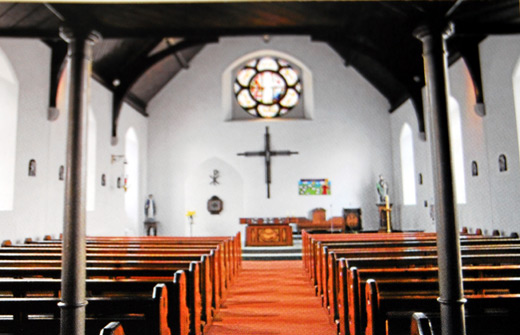
from the Souvenir Booklet on the
celebration of the Gowel Church Centenary.
Gowel Church was built just over one hundred
years ago at a cost of just fifteen hundred pounds. But that
was quite a considerable sum then, and it involved considerable
generosity on the part of the people of Gowel, their neighbours
in the rest of the parish and relatives and natives of the
area who had been forced to make their livings in foreign
fields of England, Scotland and America.
Emigration was as much a part of Irish life
one hundred years ago as it is today. Many of the people who
lived in the Gowel area existed on holdings so small that
they were unable to pay rents to the local landlord, and were
forced to visit England or Scotland regularly to earn money
at Spring sowing and at Harvestime digging of the potato crops.
When Canon Hoare and Father Hourican began
the work of raising funds for the new Chapel in Gowel a new
site at Annaghearly was generously offered. However, the people
of Gowel were determined that their church would be built
on the site of the much older Penal Church which was then
in use.
While it might have seemed desirable to move
as far away as possible from what had become a miserable and
decaying ruin, the Christians of Gowel had a strong sense
of history and a true appreciation of the Faith of their forefathers
who had built the old Penal Chapel.
The old ruined Chapel had once been the finest
Catholic Church in Ireland, a Church which was built at considerable
risk and with considerable sacrifice in tiems of persecution
by a people of Faith. Those who had built the chapel had risked
not just the threat of eviction but even the loss of life
as they erected their simple barn like structure as their
place of worship. There for many years people had come to
join in the offering of the Mass, there they had prayer, there
they had come to receive the Sacraments and there they brought
their newborn children to be Baptised in the Faith of their
Fathers. No other site no matter how suitable or how central
could replace the sacred spot on which they would worship
their God.
We know that a Dublin Architect, William
Hague drew the plans for and supervised the buidling of the
Church. The builders were local tradesmen Thomas Earley and
James McKeon. No doubt they were assisted by others from the
locality, Earley and McKeon worked in partnership on a number
of buildings in the area including the building of Kiltoghert
School. Thomas Earley was Grandfather of Tom Pat Earley who
with some of his sons was involved in the re-construction
of the Church a few years ago.
While the location of Gowel Church is now
a quiet spot apart from the times when people come to pray,
it was not always so. In the early part of the century there
were no fewer than three shops in the vicinity of the Church,
one in front of where the present Curate’s house stands
near the well in the lawn and two on the other side of the
road.
A local hall also stood almost on the site
of the present house. This house was burned by Crown Forces
(the dreaded Black and Tans) during the War of Independence.
One of the witnesses of the burning, Mrs McLoughlin of Driney
nee Ward of Gowel died just a few months ago.
The Church given to the people by the generosity
of the people of Gowel one hundred years ago has survived
because successive generations while holding on to the Faith
handed on in the true Irish tradition have themselves maintained
and refurbished the building.
As mentioned elsewhere Fr. Patrick Moran
who built the present Curate’s House, with the help
and generosity of the people of Gowel and of Leitrim then
renovated the Church just about fifty years ago, when most
if not all of the present windows were installed. The Contractor
on that occasion was Michael McLoughlin, Effernagh who had
also designed and built the imposing Curate’s Residence.
More recently the Church has been completely
refurbished in 1986 under the guidance of Fr. Michael Rigney
the then local Curate. The Contractor on that occasion was
Peter (Sonny) Moran, a native of the area, like the other
builders who have been employed on the Church over the years.
On all occasions when any work was undertaken
it was made possible by the continued generosity of the people
of the area and their friends in the rest of the Parish, and
by the generosity of many of the emigrant sons and daughters
of the area.
When the people of Gowel gather to celebrate
the centenary of the Church appropriately enough on Emigrant
Sunday, they celebrate the Faith of their Fathers who have
faithfully lived and handed on the Faith from one generation
to the next and given generously to the provision, maintenance
of their place of worship from Penal times to the present
day.
May future generations continue to be as
faithful and generous.
|




